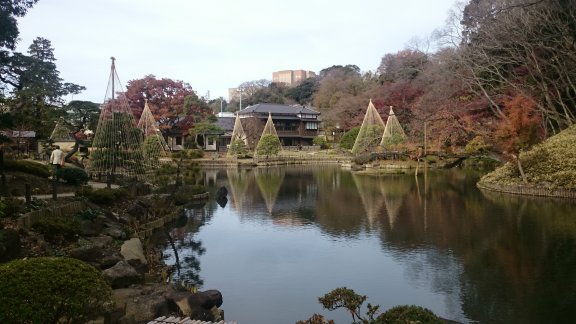 Higo-Hosokawa-teien 肥後細川庭園 Garden
Higo-Hosokawa-teien 肥後細川庭園 Garden公園やお寺の境内、神社の境内などにたくさんの美しい「日本庭園」があります。
公园、寺庙、神社境内等有很多美丽的“日本庭园”。
「飛鳥時代(592-710)」に中国から仏教と共に庭園づくりが日本に伝わりました。
During
“Asuka-jidai 飛鳥時代 Period (592-710)”, gardening along
with Buddhism from China was introduced to Japan.
The techniques of making a garden were described in a book titled “Sakutei-ki
作庭記 Treatise” that was written in “Heian-jidai 平安時代 Period (794-1185)”.
1000年前钻研得出的设计原理和技术被传承至现在。
The principles and techniques of gardening devised in eleventh century
are still applicable today.
貴族文化が花開いた「平安時代」には、「極楽浄土」を表現した「浄土庭園」が造られました。
自然が豊富な日本列島に住む日本人は、自然の曲線の中に美と安らぎを感じます。
Japanese
people living in the Japanese Archipelago, where nature is abundant, feel
beauty and peace in the natural curve.
Sometimes
nature can be brutally powerful, but it gives us more benefits.
The
layouts of “Nihon-teien Garden” emphasis an asymmetrical balance.
The pond
of “Nihon-teien Garden” is called “Chisen 池泉 Pond” and its
shape is mostly curved.
It shows
that precious water is controlled by making a pond in a straight line.
运用各种各样的手法,美得令人窒息的日本风景被浓缩在日本庭园中。
Using various methods, breathtaking beautiful Japanese landscapes are reproduced
with compact in the “Nihon-teien Garden”.
The
essence of creating a “Nihon-teien Garden” is to use natural materials while
thinking of natural scenery.
A
beautiful “Nihon-teien Garden” is a well-kept artifact.
“Nihon-teien
Garden”, where stones, water and plants are used, is kept beautiful by daily
care and cleaning.
以池塘为中心,构筑土地的起伏和假山,配置自然石头和草木,修造能欣赏四季美景的景观。
Centered on a pond, using undulations of land or the hills are built, and natural stones and vegetation are arranged to create a landscape that can be enjoyed seasonally.
“Shakkei
借景
Gardening Design Method harmonized with background” is a method of incorporating
something visible outside of “Teien 庭園 Garden”, such as natural scenery or a man-made structure, as part of
the garden.
The term “Shakkei Gardening Design Method harmonized with background” is
written in a text of landscape design “Enya 円冶” published in 1634, Ming Dynasty (1368-1644) in China.
“Shakkei
Gardening Design Method harmonized with background” can make “Teien Garden”
feel larger and more three-dimensional.
The
plants used in the “Nihon-teien garden” are called “Shokusai 植栽 Planting”, and the pine is most common.
The
evergreen pine represents perpetual prosperity.
“Shokusai
植栽 Planting” with seasonal flowers are called “Kaboku 花木”.
“Nihon-teien
Garden” where the aristocrats played on the boat in “Heian-jidai Period
(794-1185)” is called the “Shūyū-shiki-teien 舟遊式庭園 Boating garden”.
以池塘为中心、能周游的“日本庭园”,被称为“池泉回游式庭园”。
“Nihon-teien
Garden” that you can stroll around a pond is called “Chisen-kaiyū-shiki-teien 池泉回遊式庭園 Promenade garden”.
「座敷」から眺める庭園は「池泉鑑賞式庭園」と呼ばれています。
Aand “Nihon-teien Garden” that you can appreciate from the “Zashiki 座敷 Tatami room” is called “Chisen-kanshō-shiki-teien
池泉鑑賞式庭園
Garden”.
And by taking a boat, you can enjoy the scenery from a different view than
when you walk around the pond.
A hills
that are artificially made using earth and sand dug the ponds in “Nihon-teien
Garden” is called “Tsukiyama 築山 Hill”.
In “Edo-jidai
Period” “Daimyō 大名 Garden”, many “Tsukiyama Hill” inspired
by Mt. Fuji were created.
穿过池塘和水流的通道有“太鼓桥”、“飞石”、“锯齿桥”等。
There are “Taiko-bashi 太鼓橋 Bridge”, “Tobi-ishi 飛び石 Stepping Stone” and “Ziguzagu-bashi ジグザグ橋 Zigzag Bridge” in the passage across the pond and flow.
Bridges
made of various materials such as soil, stone, and wood are built over the
pond.
“Taiko-bashi
太鼓橋 Bridge”, built on a pond in the precincts of temples and shrines,
represents the crossing over from this world to the one after.
The
waterfall created in the “Nihon-tein Garden” expresses “Shin-zan Yū-koku 深山幽谷 Deep mountains and deep valleys”.
A
waterfall was also created with the theme of the legend of “Tō-ryū-mon 登龍門 Gateway to success”, where “Koi 鯉 Corp” goes up the waterfall in midstream of “Kōga 黄河 Huang he River” and become “Ryū 龍 Dragon”.
“枯山水”是日本庭园的代表形式之一。
“Kare-sansui 枯山水
Garden” is one of representative style of “Nihon-teien Garden”.
“室町时代”以后,和“禅”的思想深深地联系在一起,禅寺的枯山水造园技术发展起来了。
Since the “Muromachi-jidai 室町時代 Period (1336-1573),” “Kae-sansui
Garden” has been deeply linked to “Zen-shū 禅宗 Sect” of Buddhism, and “Kare-sansui Garden” has developed at “Zen-dera
禅寺 Temple”.
By the
concept of “Zen-shū Sect”, “Kare-sansui Garden” expresses the ocean, large
river, and the field of clouds with white sand without using any water.
This method
is called “Mitate 見立て” and expressed in something different
from the actual one.
石や砂を多用する「枯山水」は、造形美によって奥深い精神性を表しています。
“Kare-sansui
Garden,” which uses a lot of stone and sand, expresses a profound spirituality
through its beauty.
自然と造形が、調和と拮抗を繰り返す緊張感の中に美が育まれます。
“Kare-sansui
Garden,” which uses a lot of stone and sand, expresses a profound spirituality
through its beauty.
鮮やかな色彩の「花木」は、心を乱すため、「枯山水」には使用しません。
The
brightly colored “Kaboku 花木” is not used for
“Kare-sansui 枯山水 Garden” because it disturbs the mind.
“Kare-sansui
Garden” is designed to calm the heart and spirit.
“Kōyō 紅葉 Autumn leaves”, such as “Kaede 楓 Maple”, will change vivid colors but will be destined to scatter and
fade away, make you feel pitiful and fragile of life.
“Kare-sansui
Garden” at “Ryūan-ji 龍安寺 Temple” in “Kyoto 京都” is world famous.
Countless
monks have sat before a “Kare-sansui Garden” and practiced “Zazen 座禅 Meditation in Zen Buddhism”.
In “Edo-jidai Period (1603-1868)”, A samurai who was given the territory
of more than 10,000 “Goku 石” of rice (approximately 50,000 bushels) by “Bakufu 幕府 Shogunate” was called “Daimyō 大名 Feudal lord”.
江户时代,各藩之间关于造园技术的技术交流十分兴盛,园艺学、博物学等也十分发达。
Since “Edo Bakufu 江戸幕府 Shogunate” had nearly 300 “Han 藩 Clan” under its control, the total of three residences, “Kami-yashiki
Residence”, “Naka-yashiki Residence”, and “Shimo-yashiki Residence”, was nearly
1000.
At that
time, about 50 percent of the area of Edo was occupied by “Edo-yashiki
Residence”.
园内还配置了“石灯笼”、“东屋”、“茶屋”、“鹿威し(用于驱赶鸟兽的竹制添水装置)”等。
In “Nihon-teien
Garden”, there are “Ishi-tōrō 石燈籠 Stone lantern”,
“Azumaya 東屋 Rest space”, “Cha-ya 茶屋 Tea house”, “Shishi-odoshi 鹿威し” and so on.
“石灯笼”对于“日本庭园”来说,具有装饰和照明的作用。
“Ishi-tōrō
Lantern” is placed as both a decorative object and illumination for “Nihon-teien
Garden”.
“Ishi-tōrō Lantern” was also introduced from China to Japan in the sixth
century with Buddhism.
“Ishi-tōrō
Lantern” was originally intended to light a Buddha.
“鹿威し”经过一定的间隔就会发出声音,可以感受到时间的流逝。
You can feel the flow of time by making a sound at regular intervals by
“Shishi-odoshi”
初冬,在许多日本庭园里可以见到为了保护树木免受雪灾的“吊雪”。
In early
winter, You can see “Yuki-zuri 雪吊り Snow hanging” to
protect trees from snow at many “Nihon-teien Garden”.
 Higo-Hosokawa-teien 肥後細川庭園 Garden
Higo-Hosokawa-teien 肥後細川庭園 Garden